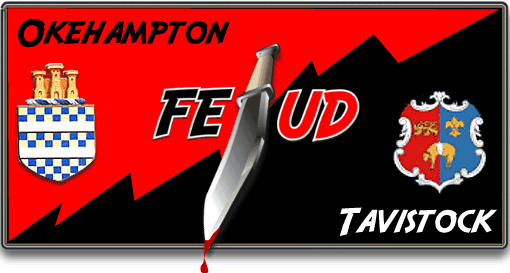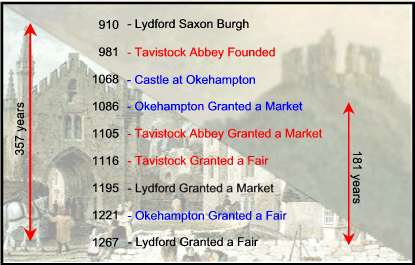
Probably ever since early man first decided to change from a nomadic lifestyle to that of a communal dweller there have been rivalries between neighbouring settlements. Very often these grudges have been harboured down through the generations until there comes a point that nobody knows why. Even so each generation is taught from a young age that, “us dawn’t ged on,” there is never any explanation as to why, probably because nobody can give the reason because their parents didn’t know why. But still the feuds continue and often manifest themselves at local gatherings such as fairs, dances etc.
At one time such a feud went on between the Okehampton and the Tavistock folk – nobody knew why just that there was always to be a deep rivalry between the two towns. In 1836 Mrs Bray (1836, pp. 170 -171) gives a typical example of how such hostilities manifested themselves:
“There was some years ago a character of this borough, in humble life, whose name was Carter Foote. On returning from Oakhampton, whither he had journeyed on business, he remounted his horse, after having enjoyed himself at the public house, and attempted to pass the river below the bridge by fording it over. The day had been stormy, and one of those sudden swells of the river (that sometimes happen in hilly countries where the currents rush rapidly from the moors) taking place, he found himself in extreme danger. After long endeavouring to struggle with the current, he leapt from his horse upon a large portion of rock, which still kept its head above water: and there the unfortunate man stood calling aloud for help, though his cries were scarcely audible from the roaring of the wind and water.
Some person going by ran and produced a rope, which he endeavoured to throw towards the rock; but finding it impossible to do so without further assistance, he begged two men, belonging to Oakhampton, who drew near the spot, to give him help and save the stranger, whose life was in so much peril. One of them, however, very leisurely looked at the sufferer, and only saying “‘Tis a Tav’stock man, let un go,” walked off with his companion, and poor Carter Foote was drowned.”
Could it just be that a trip into the dusty past would hint at some causes for this hostility? Bear in mind that Okehampton was a secular settlement that was dominated by a large castle and Tavistock was an ecclesiastical settlement dominated by a monastery. The success and prosperity of either place would be jealously watched by the other which could cause secular/ecclesiastical rivalry. But how could this happen? very easily is the basic answer and it would have involved – money and power. The very things that growth of early urban centres was dependant on was power and commerce. In the case of the ecclesiastical centres the profits from commerce went to the church and in secular centres they went to the lord. One of the early ways of generating income was from fairs and markets and so if such an event was exclusive to one particular centre clearly it had a trading monopoly. If however nearby centres also began holding markets and fairs then the revenue from such would be diluted. In the case of the Okehampton/Tavistock area there was also a third contender, namely Lydford. This became a three-horse race with Lydford eventually losing out to both Tavistock and Okehampton. The time-line below shows how the competition for trade was run over the 357 years from about AD910 – 1267:

As can be seen, over the latter 181 years there was some stiff competition for markets and fairs and although they were held on different days a certain amount of rivalry was present for the trade and custom of these events. Due mainly to geographical locations the race lost one of its competitors, namely Lydford, as Finberg explains:
“Hitherto Lydford had been the recognised commercial centre of the region between Dartmoor and the Tamar… Now, with a rival market already opened at Okehampton, its burgesses might well look with a jealous eye on the commercial autonomy of Tavistock… Thereafter Lydford fought a losing battle, watching its trade slip away to the new market, which was far more conveniently placed.”
This then left, as mentioned above, the Benedictine monks competing against the Courtenay lords of Okehampton to become the commercial centre of the area. Ironically, in the twentieth century geography played a part in Okehampton losing some of its commercial trade. Previously the main holiday route into Cornwall was the old A30 which ran through the centre of Okehampton. This brought a lot of traffic through the town much of which would stop off and bring trade into the shops. I remember vividly that during the busy holiday period it could take an hour just to get through the town. Then the by-pass was built which meant the faster dual-carriage way detoured around the town taking most of the traffic and trade with it. Tavistock however has not suffered such a set back and today continues to apparently prosper and thrive thanks to its numerous services and facilities. And dare I say it, personally I would say that finally Tavistock won its battle to become the larger commercial centre.
So, just maybe here is the deep, deep rooted cause of the one-time rivalry between the two towns – money and profit.
Bibliography.
Bray, E. 1834 A Description of the Part of Devonshire Bordering the Tamar and the Tavy, John Murray, London.
Finberg, H.P.R. 1969 Tavistock Abbey, David and Charles, Newton Abbot
 Legendary Dartmoor The many aspects past and present of Dartmoor
Legendary Dartmoor The many aspects past and present of Dartmoor
